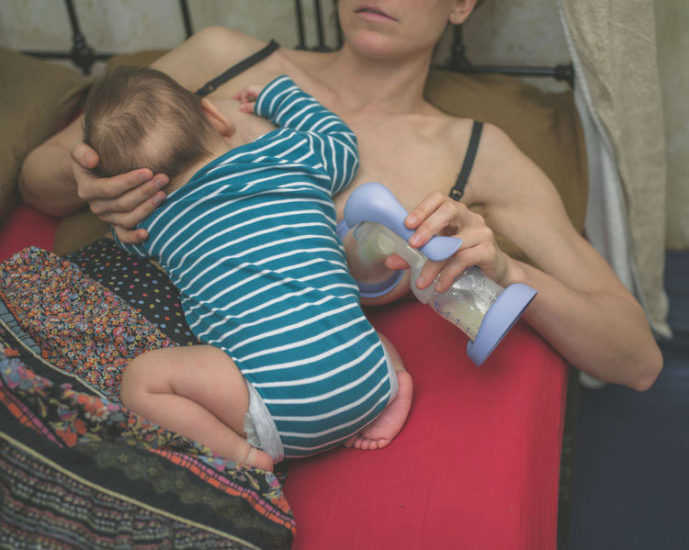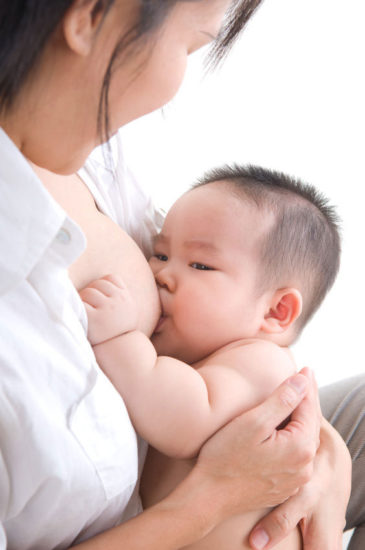Breasts that are over full or engorged with milk can feel uncomfortably full, swollen, hot, lumpy and painful. If the milk is not removed by your baby or by hand expression or a breast pump, engorged breasts can lead to mastitis (painful breast inflammation). It’s normal to have some engorgement when your milk first comes in but it can also happen unexpectedly at other times. This article describes ways to help with engorgement.
Reasons for engorgement
When milk first comes in
Many mothers will have some engorgement in the early days or weeks after birth. As the milk “comes in”, extra blood and tissue fluids will also be present in the breasts to help with milk production which may add to the feeling of fullness and congestion, especially if your baby is not feeding well. Engorgement in the breasts may be worsened if you had an intravenous (IV) drip during the birth and could take some time to clear.12 Since breast tissue can extend into the armpit, some mothers may notice they have some engorgement/a lump in their armpit as their milk comes in (see below).
Engorged breasts after the first few weeks
Although engorgement is very common in the first few weeks of your baby’s life, it can happen at any time, even during weaning. Possible causes include;
- your baby sleeping longer than expected (a missed feed)
- feeding a baby on a schedule instead of on demand
- poor position and attachment affecting how baby breastfeeds
- using a poorly fitted nipple shield
- weaning too quickly
- tight clothing or a tight bra or bag strap or even a finger pressing on the breast during a breastfeed
- having too much breast milk (oversupply)
- pumping more milk than your baby needs
- breast trauma including vigorous massage or previous breast surgery
Anything that interferes with breastfeeding on demand can increase a mother’s risk of engorgement. If painfully engorged breasts are neglected, this puts a mother at risk of breast inflammation which includes blocked ducts or mastitis. If you regularly have a lot more milk than your baby needs it may be helpful to discuss breastfeeding management with an IBCLC lactation consultant and see our article on oversupply of breast milk.
Relieving engorgement
Whatever the reason for your overly full breasts, and you may not always be sure why, softening engorged breasts with our tips below can help you feel comfortable again.
#1 Breastfeed often
Frequent breastfeeds will help relieve engorgement. Breastfeeding every couple of hours or at least 12 times in 24 hours gives your baby lots of opportunity to remove the milk that is building up. Conversely, going long periods without removing any milk can increase the discomfort. If your baby can breastfeed well, this will usually be more effective than using a breast pump. Other helpful strategies include holding your baby in as much skin-to-skin contact in the early weeks as possible, and letting baby suckle for comfort as well as nutrition.3
#2 Check positioning and attachment
The way a baby attaches to the breast (latch) and the way they are held to breastfeed (positioning) can help or hinder milk removal. When a baby has a big mouthful of breast tissue as well as the nipple in their mouth (a deep latch) it helps them remove milk efficiently and comfortably from all areas of the breast. Pamela Douglas, lactation consultant and doctor writes that certain pressures on the breast can cause inflammation, these might include pressing a finger into the breast through a feed, a deep vigorous breast massage or a poor latch.4 If breastfeeding is not comfortable ask a breastfeeding specialist to check your positioning and attachment and see Latching Tips, Breastfeeding Positions for Newborns and Why Does Breastfeeding Hurt?
Some mothers find trying different breastfeeding positions to usual can help to relieve areas of the breast that are unexpectedly engorged.
If the engorgement has changed the shape of the breast and nipple making it difficult for your baby to latch, see #3 below.
#3 Help baby to latch
If your breasts are extremely full and engorged they may feel very tight and sometimes your nipples may seem to flatten out and almost disappear. If this happens it can be difficult for a baby to latch on. When engorgement is preventing a baby from latching on, it can help to move some of the milk away from directly behind the nipple either by hand expressing or a technique known as reverse pressure softening.
Hand expression
Gently hand expressing a little milk before feeding can help soften the breast around the nipple so that baby can latch. See Hand Expressing Breast Milk for videos and further information
Reverse pressure softening
If your breasts are so full and engorged that your baby can’t latch on, a technique called reverse pressure softening can help. Reverse pressure softening can bring out a nipple flattened by severe engorgement by temporarily redistributing the extra fluid away from the nipple area back into the breast. Jean Cotterman explains more about the technique in the article below:
#4 Hand express or pump to comfort if needed
If your baby can’t breastfeed, isn’t feeding well yet, or can’t keep up with the volume of milk, you will need to remove enough milk to stay comfortable by other means than breastfeeding.
- Hand expression. Frequent hand expressing is a good way to remove excess breast milk in the early days after birth, see Hand Expressing Breast Milk for videos and further information. A pump may attract more swelling to the area before your milk is in properly by pulling more blood or tissue fluid towards the nipple. If you do use a pump at this time, keep the suction at its lowest setting and make sure the pump flange is the correct size.
- Pumping. Pumping with a good quality breast pump can help to keep the breasts comfortable if they are engorged after your milk has “come-in”. If you still feel painfully engorged after a breastfeed, a breast pump can remove enough milk until you feel comfortable again. Do not over pump as this could make the engorgement worse5 and check the pump flange is a good fit and the pump is working correctly.
- When milk won’t flow. See Engorgement Relief When Milk Won’t Flow for more ideas if you are unable to get milk flowing.
- Keep baby well fed. If your baby is not latching, any expressed milk can be given to your baby to keep him well fed until you can find some good breastfeeding help.
Expressing just enough milk to stay comfortable won’t make the engorgement worse. It is important to remove enough milk to soften the breasts, this will protect your milk supply in the days to follow and will help avoid blocked ducts or mastitis. Expressing a little milk may also make it easier for your baby to latch deeply (see #3 above).
#5 Breast movement
Natural breast movement may help to prevent breast inflammation but bra wearing and inactive lifestyles can restrict this normal movement (Douglas, Vol 18: 1–20 2022). Solutions to this could include:
- Go without a bra as much as possible (Douglas, Vol 18: 1–29 2022). For a more in depth discussion about the pros and cons of bra wearing during lactation see Nursing Bras FAQ.
- Breast gymnastics. Doctor and lactation consultant Pamela Douglas says that gentle upper limb stretches or moving the breasts in gentle circular movements with the hand or palm laid over the breast may help to prevent breast inflammation. Lactation consultant Maya Bolman calls this type of movement breast gymnastics for engorgement and she demonstrates her method in a Facebook video.
- Breast massage. Breast massage is sometimes mentioned as a way to prepare the breasts for breastfeeding or hand expressing to release milk from all areas of the breast. One study found that a light breast massage combined with hand expression helped to drain engorged breasts.6 However several authors are concerned that any kind of massage, unless professionally done, could worsen or cause breast inflammation (Douglas, Vol 18: 1–20 2022; Mitchell et al, 2022) since the ducts in the breast can be easily damaged.
If a mother is considering trying massage, it is important to do so gently so as not to bruise the breast tissue or increase inflammation (Morgensen et al, 2020). Massage techniques and therapies favoured by some lactation consultants include:
Lymphatic massage
The lymphatic system is a network of little tubes in the body that drains waste products from the cells in lymphatic fluid. Lymphatic massage is thought to help engorgement by helping to drain lymphatic fluid from the breast towards the lymph nodes in the armpits (axilla). Lactation consultant and breast surgeon Katrina Mitchell has developed a handout showing how to do this type of massage using very light touch circular movements similar to that used to stroke a cat. Douglas cautions that even gentle pressure could contribute to breast inflammation (Douglas, Vol 18: 1–20 2022).
Therapeutic Breast Massage
A technique popularised by Maya Bolman of Breastfeeding Medicine of Northeast Ohio called Therapeutic Breast Massage in Lactation (TBML) involves alternating breast massage with hand expression (see video).7 As above, this type of gentle massage is also said to help drain lymph/tissue fluid from the breast via the lymphatic system in the armpits.8
Circular massage
Global health Media summarises six steps to take to relieve engorgement in the following video and describes a massage involving making circular hand movements at 01:40.
Other physical therapies
Mogensen et al discuss a number of other physical therapies that may help relieve engorgement including therapeutic ultrasound and cupping therapy.
- Ultrasound is used by medical professionals to reduce pain and increase circulation and some mothers have found it helped improve the symptoms of engorgement. However Douglas states that there is no evidence supporting the use of therapeutic ultrasound in lactation (Douglas, Vol 18: 1–20 2022) and cites a systematic review that found no positive effect.9
- Cupping therapy is a traditional Chinese medicine technique performed by a physical therapist that uses suction cups to create a vacuum to improve lymphatic fluid drainage (Mogensen et al, 2019).
#6 Cold therapy and cabbage
Cold compresses (e.g. frozen peas or crushed ice in a damp cloth) placed against any sore areas of the breast for up to 20 minutes at a time, or chilled cabbage leaves 1011 in your bra can provide pain relief between feeds (Mitchell et al, 2022). The Womanly Art of Breastfeeding, a popular breastfeeding book, explains more about cabbage and cold therapy:
- Use green cabbage (red can stain), which may help reduce swelling [Stop use if a skin rash or other signs of allergy appear]. Remove the outer leaves in case there are any pesticides on them. Tear off some inner leaves, tear out the hard central stem, crumple the leaves gently in your hand, and apply them to your breast (not over your nipple, so the taste isn’t left behind to bother your baby). Doesn’t that feel wonderful? You can wear them inside a bra or under a tight shirt to keep them in place. replace the leaves with fresh ones whenever you want to.
- Inflammation responds best to cold. Wrap a bag of frozen peas (or carrots) in a small towel and use it as a cold compress, alternating about twenty minutes on and twenty minutes off, as much as you like. Refreeze as needed. If you feel like a hot shower, let the water play over your back, not your chest. Same for a heating pad.
#7 Pain relief
If engorgement is very painful, appropriate pain relief or anti-inflammatory medication can help with the pain and accompanying inflammation (Mitchell et al, 2022). Pain relief may also help the let-down reflex12 however Pamela Douglas cautions that over reliance on medication could interfere with the body’s own systems to calm the inflammatory response (Douglas, Vol 18: 1–20 2022).
Warmth before a feed
Some authors recommend placing a warm compress or warm towels on the breast just before pumping (or breastfeeding) as a little warmth can help with the let-down reflex and also provide some pain relief (Lawrence, 2016). It’s important not to go too warm as too much heat could bring more blood to the area and make the engorgement worse.
#8 Gravity
The Womanly Art of Breastfeeding suggests lying flat on your back to rest allows gravity to help drain fluids away from the breasts.13 Trying reverse pressure softening while lying down can be helpful to release engorgement behind the nipple.
Lumps in the armpit
Breast tissue extends into the armpit (called the Tail of Spence) and this breast tissue could become engorged in the form of a lump in the armpit. Engorgement here will respond to the same measures used for engorgement in other areas of the breast such as frequent breastfeeds and cold therapy. Occasionally the lump in the armpit will be swollen glandular tissue that does not drain into the rest of the breast; cold compresses for pain relief and a little time will help this to resolve naturally. Note: extra milk making glandular tissue can also be found in other parts of the body on the ‘milk line’.14 Persistent lumps should always be checked with a health professional.
Summary
Breasts that are over full with milk are known as engorged. Engorgement in the early weeks may also include blood and tissue fluid in the breast as well as breast milk. If engorgement is left unchecked it could develop into painful mastitis (inflammation of the breast). Breastfeeding frequently, hand expressing or pumping to stay comfortable, and gentle breast movement can all help to reduce breast engorgement and avoid mastitis. If you are having trouble expressing any milk see Engorgement Relief When Milk Won’t Flow. If you do develop symptoms of mastitis and are not starting to feel better after 12-24 hours of treatment, contact your health professional for advice. See Mastitis Symptoms and Treatment for further information.
*Extract reproduced by permission from Pinter & Martin



